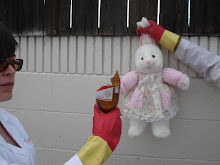Soil is divided into five horizons:
 O-horizon: O for organics. Lots of loose debris like dead leaves and dead asshole bees that will sting you even though they're dead.
O-horizon: O for organics. Lots of loose debris like dead leaves and dead asshole bees that will sting you even though they're dead.A-horizon: The darker layer just below the O-horizon. Mixture of organics and sediment. Lots of live bugs.
B-horizon: More sediment than A-horizon. Lighter color, less organic material
C-horizon: Less of what we think of as “soil”, more weathered bedrock – bedrock being the super hard stuff that is way under the soil. Something like granite or slate or gneiss (see “Rocks for Jocks”)
R-horizon: Unweathered bedrock.
Soils are classified kinda like sedimentary rocks: according to their grain size. You’ve got fine stuff like clay and silt, then sand of various sizes, then gravel, cobble and finally boulders. What you do when you’re an engineer is construct a graph like this called a grading curve:

On your y-axis you have the % that passes thru a sieve of a particular size, also considered “percentage finer”. On your x-axis you’ve got grain size on a logarithmic scale (see "Science Lesson #4: MAGNITUDES! for a refresher on logarithims). Over on the left side of your x-axis you have itty-bitty grains like what would be in clays and silts. But as you move over to the right side of the x-axis you’ve got sediments the size of rocks and pebbles and the like.
Let's do a thought experiment: Say you’re in charge of classifying a soil that something big and important will be built on. Like a new burrito shop. How do you do it? Start by collecting a soil sample and running through a sieve that’s pretty porous (i.e. large holes). Drop the soil in the sieve and see how much comes out the bottom. If it’s a lot, meaning that your soil is relatively free of big rocks and pebbles, you say to yourself “this soil is 100% finer than the size of this sieve”. You move on to a smaller size sieve. About 80% of your sample comes out the bottom therefore 80% of your soils is finer than that sieve size. You keep doing this until you get to a sieve that is so fine none of your soil can get through. At that point you’ve got 0% finer and CONGRADULATIONS! You’ve constructed a grading curve.
Knowing what kind of soil you’re building on is important for a multitude of reasons. Moisture causes a lot of problems because certain types of clays start to behave like putty when they’re wet. Or you can get a soil that doesn’t compact very well or looses cohesion. Lots of engineering problems arise when you’re dealing with soil. Drainage, plumbing, septic tanks, gas and electrical lines are all things that you don’t want bad soil to muss up. So I guess soil is pretty important after all. Don’t ignore soil or soil will ignore you!*
* It pretty much does this already.

